Armored decked lightning. Cruiser II rank "Novik". Cost / Efficiency Criterion
Someone such a union may seem strange, but let's not forget that the main means of transmitting information between ships at the end of 19, the beginning of 20, were flag signals. And even during the First World War, radio stations were not yet completely reliable - in the same battle of Jutland, many sent radiograms did not reach their destination.
Oddly enough, in terms of communications, Novik does not deserve a single good word. He had only one mast, which created a whole set of problems. So, for example, A. Emelin indicates the impossibility of raising multi-flag signals, although it is not entirely clear why, in the author’s opinion, the presence of only one mast could complicate, but not prevent, an absolutely similar signal. In addition, one mast made it difficult to place a wireless telegraph antenna. There were other non-communication flaws - the difficulty of pulling out the clothes line, the lack of a second masthead light on the ship - the latter made it difficult at night to determine the cruiser’s course, creating a danger of collision. Moreover, according to A. Emelin, all these shortcomings were obvious at the time of the design of the ship and why the MTK did not require the addition of another mast - it is completely unclear. Perhaps, of course, it was a matter of fear of overload, we see that German designers strove for perfect minimization of weights, but in fairness we note that the Novik is far from the last "single mast" cruiser of the Russian Imperial fleet. So, already after the Russo-Japanese War, the armored cruiser Bayan with one mast was being built, the other cruiser, the Rurik, was originally designed as a two-mast, but during the construction process one of the masts was abandoned, etc. In general, it can be said that the reasons for installing only one mast are unclear, but this was not the optimal solution, creating the problems listed above.
Moreover, such a decision was in no way suitable for ships intended for service during a squadron. The fact is that, in addition to reconnaissance, small cruisers could play the role of repeating ships - the essence of this task was as follows. As you know, the ability to control the squadron of those times did not allow the admiral to carry out command from the middle of the system. The flagship necessarily had to go with the lead ship: it is interesting that the Japanese, who occasionally used the turns “all at once”, necessarily put the ship of the younger flagship in closing. Thus, the combat detachment was led by the flagship, and if the combat situation demanded a “all-suddenly” turn, then the direct control of the maneuvering was assigned to his immediate deputy and the most experienced commander (after the detachment head admiral).
Thus, if the admiral wanted to give the command a flag signal, he, of course, raised it, but the problem was that this signal was clearly visible only from the next ship following the flagship. The third ship in the ranks saw this signal badly, from the fourth it was almost imperceptible. That is why according to the rules of that time, after the flagship raised the signal (say, for rebuilding), the ships had to rehearse it (that is, pick up the same on the files) and only then, when the commander made sure that the signal was noticed and understood by everyone, followed by the command "Run!". All of this took a lot of time, and it is not surprising that the admirals of those times preferred to control their personal example, since in the absence of other signals, the other ships had to follow the flagship, keeping their ranks.
However, of course, not all orders and instructions can be transferred by changing the course of the flagship. Therefore, there was a need for repetitious ships - such were to be located on the opposite side of the enemy from the squadron, and immediately duplicate the flagship signals - on a ship located outside the structure, these signals would be clearly visible along the entire line. The Novik, being a high-speed cruiser, could easily perform this function after the enemy squadron was within the direct line of sight of the main Russian forces, and the need for reconnaissance would have disappeared, but it was not enough for this alone.
And the situation with the radio station was just as bad. The “wireless telegraphy apparatus” onboard the ship provided a range of radio communications of no more than 15-17 miles (28-32 km), but at the same time raised banner flags interfered with its operation. At the same time, on the move, the wireless telegraph refused to work at all, as noted in the report of Stepan Osipovich Makarov (when he was the commander of the Pacific Squadron in Port Arthur), the governor of Ye.A. Alekseev and V.K. Vitgefta, Chief Inspector of the Mine Case, Vice Admiral K.S. Ostreletsky.
In general, strange as it may sound, the cruiser designed for the intelligence service was very poorly equipped for it.
Crew
There are also some ambiguities with his number, because 328 people are usually pointed out, including 12 officers. Nevertheless, A. Emelin in his monograph indicates that the cruiser during its transfer to the fleet was staffed with “three staff officers, eight chief officers, two mechanical engineers, 42 non-commissioned officers and 268 privates,” that is, 323 person No less interesting is that in the photo of the officers of the ship we can see the 15 people.
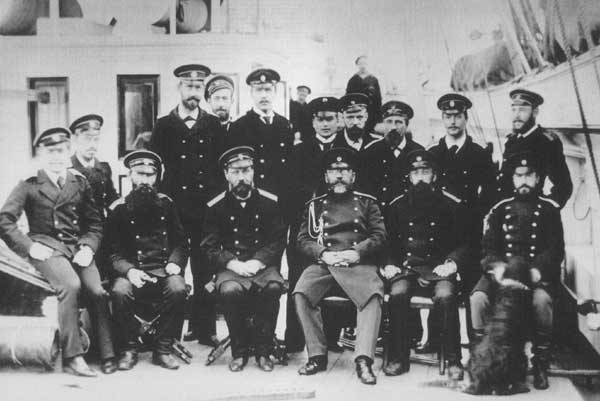
Studying the list of officers who served on Novik during its presence in the Russian Imperial Navy, we can conclude on their composition: commander, senior officer, auditor, navigator officer, artillery officer, four watch officers and watch officers, senior ship mechanic , bilge mechanic, junior mechanic, mine mechanic, ship's doctor, and all - 14 people, but this, again, is not accurate.
As for the accommodation conditions, the officers' cabins were comfortable and functional, but the conditions in which the rest of the crew was located differed from other cruisers of the Russian fleet for the worse. In those years, the classic bed of sailors was a suspended bed - a special type of hammock, which became very popular on the ships of the world. However, as N.O. von Essen:
Note that the heating of the deck was also due to the fact that the Novik designers, trying to make the ship as easy as possible, used linoleum to cover the decks, which, of course, never belonged to heat-resistant materials. But besides this, linoleum had a lot of flaws. The sun, the salty air, the heat from the cars and boilers, the loading of coal — all these were loads that the linoleum was unable to withstand for a long time. BUT. Von Essen noted that the linoleum on the residential deck had softened so much that it even had traces of a person walking along it, and of course, it was torn and quickly turned into rags. In Port Arthur, linoleum was replaced, but he quickly came to a complete disrepair, but did not have time to implement the proposal to stack asbestos sheets under it to prevent its heating.
But the real problem, of course, was linoleum on the upper deck. There, he was getting extremely slippery from getting wet, it was almost impossible to walk on the upper deck when it was raining or having a strong emotion, it was almost impossible - what can we say about shooting from guns or fighting for survivability! And, of course, the linoleum on the upper deck just as quickly turned into tatters (however, perhaps it was for the better).
Cruiser Scale Distribution
It must be said that the weight list of the Novik cruiser of the 2 rank is not quite clear. So, A. Emelin cites the following load of the ship’s masses, taken, apparently, from the “Schihau” reporting documents (in brackets - the percentage of normal displacement):
Normal displacement - 2 719,125 t (100%);
Enclosure - 1 219,858 T (44,86%);
Various equipment - 97,786 t (3,6%);
Machines and boilers - 790,417 t (29,07%);
Artillery - 83,304 t (3,06%);
Ammunition - 67,76 t (2,49%);
Coal - 360 t (13,24%);
Team with things - 49,5 t (1,82%);
Provisions for 6 weeks - 38,5 t (1,42%);
Freshwater on 8 days - 12 T (0,44%).
It seems that everything is clear, but in the materials of S.O. Makarov, there are other data - the case with the supply of 42,3%, mechanisms, boilers and water supply to them - 26,7%, armor - 10,43%, artillery with ammunition - 4,73%, mine armament - 3,36%. According to the author of this article, the data found in Stepan Osipovich is incorrect. The fact is that the sum of all the shares according to the loads of the masses gives 87,52%, respectively, only 12,48% remains for the fuel (coal). But the fact that the reserve of coal in the amount of 360 tons was taken into account for the normal displacement of the ship is known reliably and cannot be doubted. And if the indicated 360 tons make up the 12,48% of the normal displacement of the Novik, it turns out that this displacement itself amounts to 2 884,6 tons, and this figure does not appear in any sources.
It is interesting to compare the weight loads of the Novik cruiser with its “elder brothers” - big armored cruisers of the “Bogatyr” type.
Or rather, with “Oleg,” because of the distribution of the loads available to the author, his list in its structure corresponds to Novik more than others.
The specific weight of the Oleg hull in the normal displacement was 37,88%. Novik seems to have more (44,86%), but these are peculiarities in the compilation of weight lists: in the German statement, the armor deck was included in the hull mass, and in the Russian one it was taken into account under the item “booking”. Eliminating the armor deck (for “novikov” of domestic construction, “Pearls” and “Emerald”, its mass was 345 tons, and according to documents of S.O. Makarov - 294 tons), we get the share of the Novik case - 32-34% from normal displacement. And this, again, is an overestimated assessment, since, apparently, the Germans also appeared in the article “Corps” for the armor of the cabin and the pipes for it — there was simply no reservation for Novik. But in general, it can be stated that the corps regarding the Bogatyr project is greatly facilitated. Although, no doubt, thanks to the greater specific mass of the hull, the Oleg had an advantage over Novik in both seaworthiness and stability, as an artillery platform.
Novik’s machines and boilers are significantly lighter — due to the use of “miner” boilers, as well as due to lighter and more compact screws and shafts (it is clear that more than twice the heavy “Oleg” required “a little bit larger”) Novika had roughly 790,5 tons, at rated power 17 000 hp, while at Oleg, 1 200 tons at rated power 19 500 hp, That is, according to the specific power, Novika power plant ( 22,14 hp / t) slightly more than 36% exceeded that of Oleg (16,25 hp / t). But, despite this, the share of machines and boilers "Novik" was 29,07% "Novik", and only 18,63% - "Oleg." Here it is - pay for speed!
12,48% of normal displacement went to Novik’s reservation, and Oleg had 13,43%, but in practice this meant that Novik received only 345 tons of armor (including a little more), and Oleg 865 t. Is it any wonder that not only the armored deck on the “Oleg” turned out to be thicker (35-70 mm versus the 30-50 mm on the Novik), but chimneys and grain elevators above the armored deck were also booked on "Novik" was not at all). More spacious conning tower received a powerful 140 mm armor, and from 12 shells of the main caliber 8 were in towers and casemates. In fact, the placement of four guns in the towers was a very dubious innovation (different shooting speeds with deck and casemate guns, difficulties with centralized fire control), but if you consider this solution only in terms of protection, then of course the towers guns "Novik".
And, of course, the main thing is artillery armament. At Novik, artillery and ammunition accounted for 5,55% of normal displacement, or just slightly more than 151 ton. Moreover, there is a reasonable assumption that mine armaments were also included in the indicated 151 t (it was not separately allocated, and the total weight of the artillery mounts is much less than those indicated in the 83,3 t statement). At Oleg, the artillery (together with the weight of the tower mechanisms, but without tower armor) weighed 552 tons, and together with mine weapons - 686 tons, or 10,65% of the normal displacement! There is no doubt that the 12 * 152-mm and the same 75-mm “Oleg” guns (not counting the 8 * 47-mm, 2 * 37-mm and machine guns) exceeded the firepower of even two Novik cruisers.
Thus, we see that, despite the use of lighter boilers, despite the full relief of the hull and significant “gaps” in the booking of the relatively armored cruiser “Oleg”, the firepower was subjected to the maximum reduction (both in absolute and in relative terms) the ship. It was she who had to sacrifice for Novik's record speed.
Cost of construction
The total cost of the 2-grade Novik armored cruiser was 3 391 314 rubles, including:
1. Hull (including the cost of combat and deck electric lighting and artillery feed) - 913 500 rub .;
2. Mechanisms and boilers - 1 702 459 rub .;
3. Armor - 190 578 rub .;
4. General equipment - 89 789 rub .;
5. Artillery - 194 808 rub .;
6. Artillery supply - 168 644 rub .;
7. Mine equipment and electrical engineering - 72 904 rub.
8. Mine supply - 58 632 rub.
I would like to note that the cost of the contract with the firm "Schihau" was a smaller amount - 2 870 000 rub., But it did not include artillery and mine weapons with supplies and ammunition, and besides, apparently, also cargo passing under the article "General equipment". If we sum up the cost of the hull, mechanisms and boilers, as well as armor from the above calculation, we get 2 806 537 rubles, which is extremely similar to the contract amount.
I would like to draw the attention of a respected reader to such a nuance. The cost of all cruiser artillery was 194,8 thousand rubles. but the cost of ammunition for them (hardly it was a question of more than double ammunition) - 168,6 thousand rubles. that is, almost as much as the artillery itself. This ratio demonstrates well how costly and complex ammunition production was in those years, and can provide insight (but certainly not an excuse) to the desire of our Maritime Department to reduce costs for this item in the cost of the maritime budget.
The cost of the Bogatyr armored cruiser, taken from the “All-Aid Report on the Maritime Office for 1897-1900 Years” “with mechanisms, armor, artillery, mines and combat supplies,” was 5 509 711 rubles. In this case, the comparison with “The Bogatyr” is correct, because both Novik and Bogatyr were built on German shipyards, that is, the difference in pricing and production culture is minimized. But the results of the comparison is difficult to judge unequivocally.
On the one hand, of course, Novik is much cheaper - its total cost is 61,55% of that of Bogatyr, but on the other, it turns out that Novik’s 3 and one 350-ton destroyer would have cost the Russian treasury even a little more than 2 Bogatyr. At the same time, even the Bogatyr surpasses the Novik 2, the Bogatyr’s speed, although lower than the Novik, is still higher than the vast majority of the world’s armored cruisers, combat stability is also higher, and the only indisputable advantage "Novikov" is that three ships of this type can be in three different places at the same time, and two "Bogatyr" lined up almost in the same money - only in two.
Even more dubious is the construction of Novik-class cruisers against the background of the Bayan armored cruiser. The latter, built at the shipyard of France, cost the Russian treasury 6 964 725 rubles, that is, about two "Novik". “Bayan” was also significantly inferior to “Novik” in speed - on tests, an armored cruiser could “reach out” to the 21 node, developing 20,97 knots. However, the Bayan was an armored cruiser with a turret arrangement of two 203-mm guns and a casemate - 152-mm, as well as a very powerful armor belt with a thickness of up to 200 mm.
In other words, both the Bayan and the Novikov couple could conduct reconnaissance and detect the enemy squadron. But it was dangerous for Novikam to take on a battle with enemy cruisers of a similar purpose, a pair of enemy cruiseers could well, if not destroy, then push them aside. But "Bayan" would not even notice such an opponent. "Bayan" not only could come in direct visibility with the enemy squadron, but for a long time to watch her, maintaining contact - and the enemy cruiser reconnaissance aircraft could not drive him away. For this, one would have to send large armored cruisers into battle, that is, to split up the battle formation, which was not very good near the enemy forces. The Bayan, with its powerful armor and well-protected artillery, was a warship extremely dangerous for any armored cruiser, but he could also support his main forces in artillery fighting without too much fear of return fire. Only 305-mm armadillo guns were really dangerous for him, but even under their shelling, he could still hold out for a while. But for Novik, any hit of a heavy projectile was fraught with critical damage.
However, two cruisers will always have a big advantage over one, simply because there are two of them, and they can solve problems in different places. In addition, there are still situations where high speed becomes crucial. But, again, speaking of speed - the cruiser "Askold", although it did not have such combat stability, which distinguished the cruiser type "Bogatyr", but obviously surpassed in this indicator "Novik", almost not inferior to the latter in speed (1-1,5 knots). Artillery "Askold" cost two "Novikov", and it cost less "Bogatyr" (5 196 205 rub). Who knows what was better for the fleet: two Askolds, or three Novikas?
If we compare the "Novik" with the destroyers, then everything is ambiguous. Four 350-ton destroyers that were built for Russia of the same “Shikhau” cost the treasury in 2 993 744 rubles, that is, one destroyer cost about 748 thousand rubles. (with weapons, of course). In this case, the German destroyers (type "Whale") were quite successful ships. Having 1 * 75-mm, 5 * 47-mm and three torpedo tubes with 381-mm caliber, "Whales" became one of the most heavily armed Russian "fighters". At the same time, the Germans were able to provide these destroyers with a half-tank, which had a great effect on their seaworthiness, and their speed exceeded the 27 nodes (on tests, of course, in everyday use it was less). It turns out that for the cost of one "Novik" one could build 4,5 of such destroyers, and how to say what is better here? In some situations, a cruiser would be more useful, in some - destroyers.
We have now compared the "Novik" with a very expensive fighter type "Kit". Domestic shipyards built 350-ton destroyers cheaper - the average price was 611 thousand rubles. But if you take 220-ton "destroyers of the Sokol type", then their price did not exceed 412 thousand rubles. It turns out that for one "Novik" it would be possible to build five and a half "350-ton" or eight "220-ton" destroyer!
In general, our preliminary analysis of the “Novik” on the “cost / effectiveness” scale (we can only talk about the final one when we study the combat path of this ship) says this. The Novik was, of course, cheaper than the “standard” Russian armored cruiser in the 6 000 - 6 500 with a displacement, but it was not certain that it was a cheap ship. Strictly speaking, it turned out this way - for the same money, one could build either a series of large armored cruisers, or one and a half times more “Novikov”, which were somewhat superior to Russian 23-node ships in speed, but categorically inferior to them in combat power and sustainability. Was the game worth the candle? At the end of our cycle, we will try to answer this question.
Construction and testing
As we said earlier, the construction of the Novik began in December 1899. At the end of February 1900, when the cruiser was officially laid down, its hull was already brought to the level of an armored deck. The launch of 2 took place on August of the same year, and on May 2, the ship reached the first tests, and they ended only on April 1901, 23. Thus, the slip-on period was approximately 1902 months, the completion was 7 months, but the tests the ships took almost a year - just from the moment of the start of work and before the entry of Novik into the Russian Imperial Navy, the year 9 and the month 2 passed.
Interestingly, the construction of the ship, on the one hand, was carried out with a purely German thoroughness: for example, the captain of the 2 rank of P.F. Gavrilov 1, who later became commander of a cruiser, and while he was in charge of supervising the construction of Novik and four more 350-ton destroyers, also ordered from Shikhau by the Russian fleet, was delighted with:
On the other hand, oddly enough, the German shipbuilders were not alien to such, recognized by many for purely Russian qualities, like sturmovshchina and the desire to "report before the holiday date." So, for example, the company was in a hurry to work in order to launch Novik into the water six months after its inception - and this was done only from a desire to involve in the solemn ceremony the emperors of Russia and Germany, who were to meet in May-June Danzig. But as soon as the meeting was postponed, as soon as the “extra-urgent” launch was canceled, the director of the company immediately “remembered” that it was more convenient to carry out the installation work on the stocks ...
The tests of the mechanisms of the newly built ship are not in vain called progressive - their power is increased gradually, in the course of several exits to the sea, checking how well they "behave" at consistently increasing load. But the representatives of “Shikhau”, apparently, were eaten up by impatience, therefore already at the time of the first exit, contrary to the generally accepted rules, they gave the 24 node. Nothing terrible happened, and 11 May 1902 g., During the second release of "Novik" they tried to give full speed. Alas, everything happened in full accordance with the proverb “Hurry up - make fun of people”: the cruiser developed 24,2 bonds. and got a breakage of the coupling of one of the screws. Subsequently, observing the construction of "Novik" his first commander P.F. Gavrilov wrote:
Of the seven exits to the sea in 1901, four ended with breakdowns of screws and machines. In mid-September, tests had to be interrupted due to weather conditions, due to strong autumn winds. In addition, Novik had several serious but not yet resolved problems: the presence of shells on the propeller shafts, the problems of flooding the stern cartridge cellar (instead of the set 15 minutes, it was “heated” by 53 min.) a significant movement of the hull in a horizontal plane about the middle of the length of the vessel, that is, near the room of the onboard machines. "
Naturally, all this required elimination, with such shortcomings the cruiser could not be accepted by the fleet, so the Novik had to stay for the winter in Germany. All of these problems were resolved and 23 April 1902. Novik completed the official tests successfully.
German magazine Die Flotte wrote:
Omitting the funny fact that the article appeared in the January issue of this reputable magazine, that is, before Novik completed the official tests, we have to completely agree with the opinion expressed in it. One can argue about the correctness of the tactical justification of this type of ship, but the fact that it really was a completely new type of high-speed cruiser, and its design and construction was a complex engineering task, which the German shipbuilders coped with "excellent" , no doubt.
To be continued ...
- Andrei from Chelyabinsk
- Armored decked lightning. Cruiser II rank "Novik"
Armored decked lightning. The cruiser of the second rank "Novik". Design features
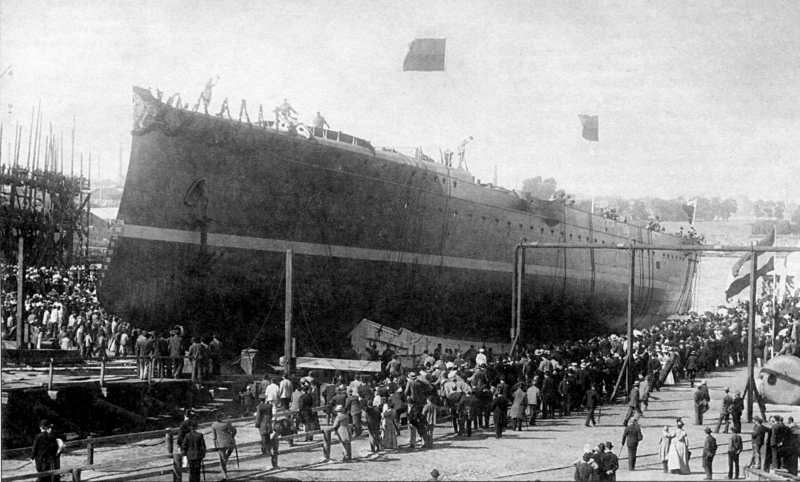
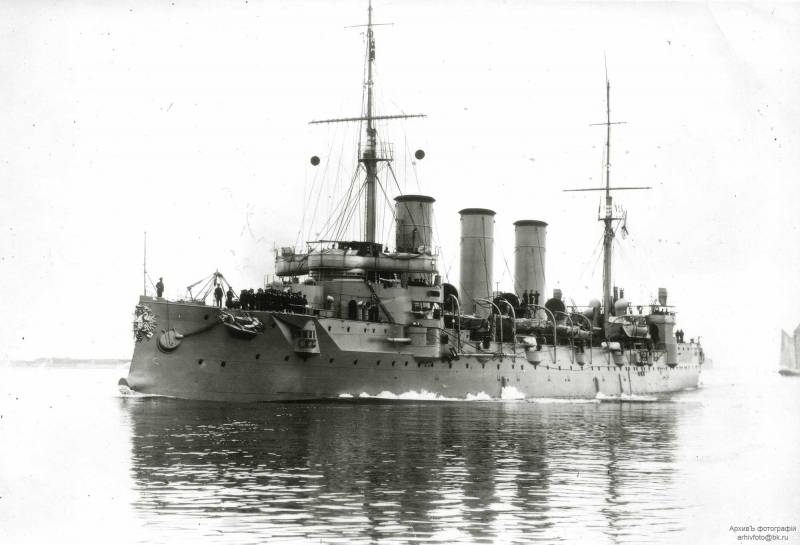
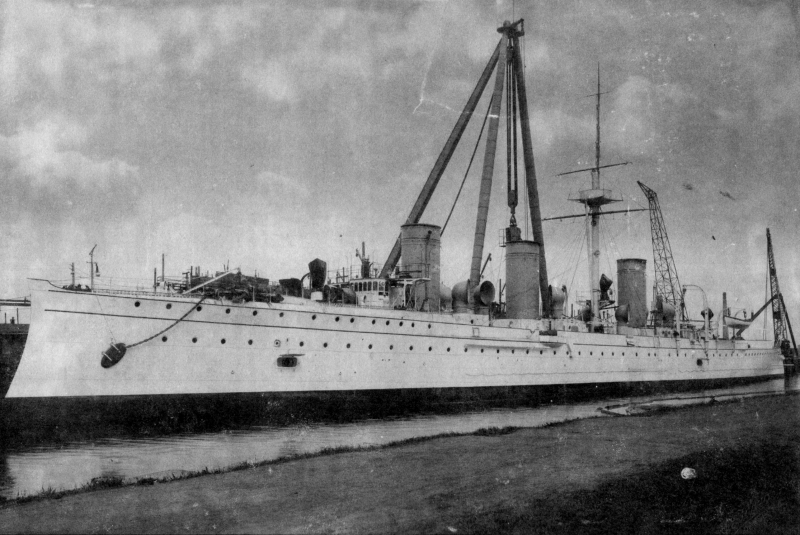
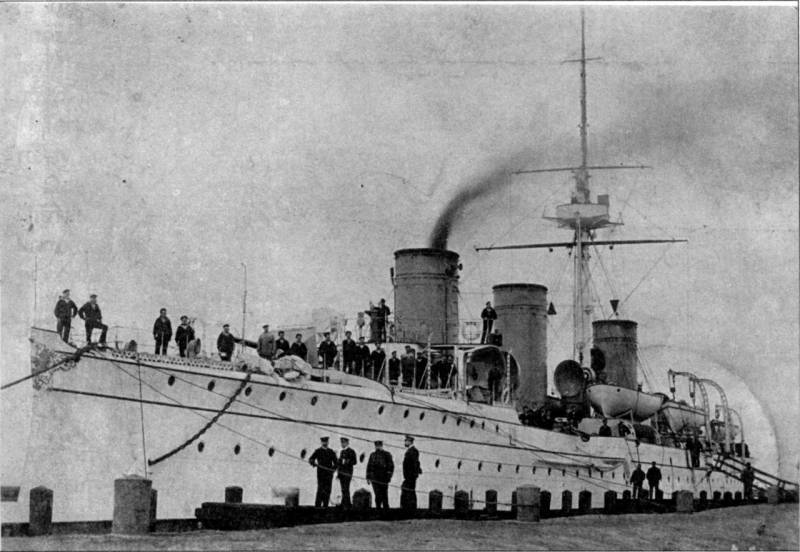
Information